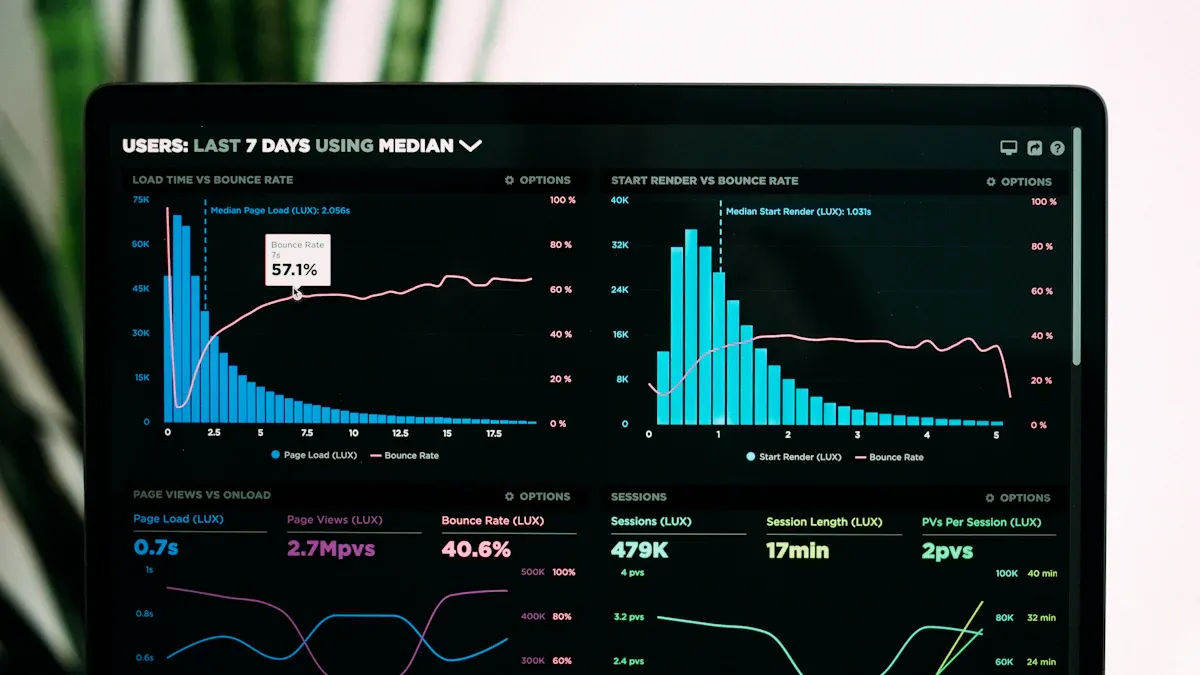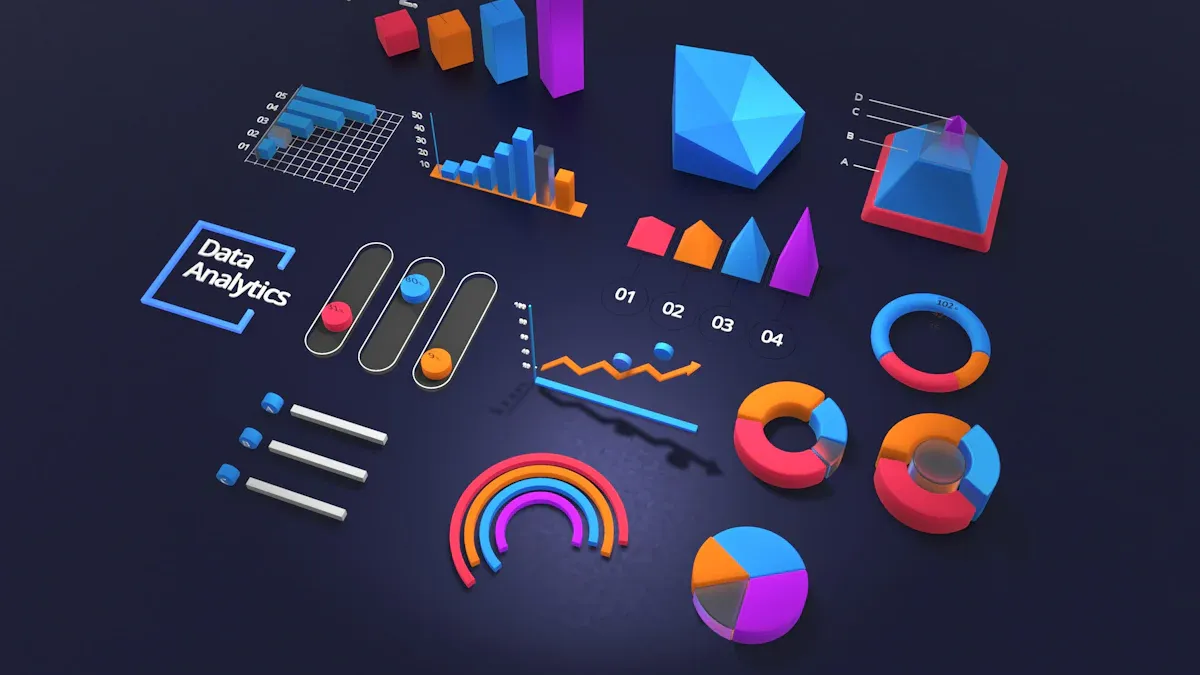AI Strategies for Maximizing Customer Lifetime Value

Customer Lifetime Value (CLV) shows how much money a customer brings to your business over time. A high CLV means customers stay loyal and your business earns well. For example, businesses aim for an LTV/CAC ratio of 3:1 to ensure good profits. AI strategies are transforming how businesses enhance CLV by providing tools to better understand customers, create personalized experiences, and maintain customer satisfaction. Stories illustrate how online companies implement AI strategies to prevent customer loss and improve deliveries, ensuring packages arrive on time to keep customers happy. These advancements highlight the significance of AI strategies for fostering long-term growth in businesses.
Key Takeaways
Knowing Customer Lifetime Value (CLV) helps businesses choose smarter ways to market and care for customers.
AI can predict what customers might do next and help businesses adjust their marketing plans.
AI suggestions make shopping more personal, keeping customers happy and loyal, which boosts sales.
AI-powered pricing can help businesses earn more while giving fair prices to customers.
Checking and improving AI tools often makes sure they meet business goals and make customers happier.
Understanding Customer Lifetime Value (CLV)

What is CLV and Why It Matters
Customer Lifetime Value (CLV) shows how much money a customer spends with your business over time. It helps you see how important each customer is. By focusing on CLV, you can make better choices about ads, prices, and customer care.
CLV predicts how much profit a customer will bring in the future. Businesses that study CLV can stay ahead of others. For example:
You can guess future earnings more easily.
You can spot when customers might stop buying.
You can design special ads for different groups of customers.
You can set prices that balance costs and profits.
Reports show that making customers happy increases CLV. When customers feel cared for, they stay longer and spend more, which grows your income.
Key Idea | Explanation |
|---|---|
What is CLTV | It measures how much money a customer brings over time. |
Why CLTV is Important | Loyal customers help your business grow steadily. |
Role of Customer Experience | Happy customers stay longer and spend more. |
How to Calculate CLV
Figuring out CLV shows how much money your customers bring to your business. There are different ways to calculate it, each giving useful details:
Method | Explanation | Source |
|---|---|---|
Net Present Value (NPV) | Finds today’s value of future profits by adjusting for time. | Blattberg and Deighton (1996), Lehmann and Gupta (2005) |
Customer Retention Impact | Shows how keeping customers boosts business value. | Gupta et al. (2004) |
Ensemble Methods | Uses many models together to predict CLV better. | Dwyer (1989), Venkatesan and Kumar (2004) |
For instance, the NPV method helps you see how much your customers are worth in the long run. Retention-based methods show how keeping customers loyal can grow your business value.
What Affects CLV
Many things affect CLV, but two are key: how long customers stay and interest rates. Retention rate shows how loyal customers are. Higher loyalty means higher CLV. Interest rates change how much future earnings are worth today. Managing these well helps you plan better and earn more.
Customer experience also matters a lot. Studies show solving customer problems quickly makes them buy more later. Helping customers builds trust and loyalty, which raises CLV.
Using AI tools, you can study these factors better. AI helps predict what customers will do, create personal experiences, and find ways to improve. This keeps your business ahead in tough markets.
AI Strategies for Maximizing CLV

Using Predictive Analytics to Understand Customers
Predictive analytics helps you learn about your customers. It looks at their past actions to guess what they might do next. This AI tool finds patterns in data like shopping history, website visits, and how often they interact. These details help you make smart choices to keep customers happy and loyal.
For example, predictive analytics groups customers by their lifetime value. This grouping lets you create better ads and use resources wisely. Research shows businesses using predictive tools see a 145% return on investment, compared to 89% for others. It also matches products and deals to what customers like, making marketing more effective.
Tip: Spot customers who might leave and give them special offers. A phone company cut customer loss by 20% using this method.
Customer Action | |
|---|---|
Followed Terpli suggestions | 95.25% |
Wrote a Terpli-powered review | 238.59% |
General CLTV rise in dispensaries | 40.5% to 307.9% |
Used suggestions and wrote reviews | Up to 543% |
Personalization with AI Recommendations
Personalization makes customers feel special and keeps them coming back. AI recommendation systems study customer data to suggest items they might like. This boosts sales and builds stronger customer relationships.
Big companies like Amazon and Netflix use this well. Amazon suggests products based on what you’ve browsed or bought, increasing sales and happiness. Netflix recommends shows and movies you’ll enjoy, keeping viewers interested and reducing cancellations.
Example | Application | Outcome |
|---|---|---|
Amazon | Suggests products based on browsing and buying habits. | Increases sales and customer happiness. |
Netflix | Recommends shows and movies using AI. | Keeps viewers watching and lowers dropouts. |
Starbucks | Sends custom offers through its app using loyalty data. | Boosts customer interest and loyalty. |
Fast-growing companies earn 40% more from personalization than slower ones. Personalized experiences make customers happier, which leads to more profits.
Note: Retailers using AI personalization have seen big jumps in sales and customer spending.
Smart Pricing for Better Profits
Dynamic pricing changes prices based on demand, rivals, and customer habits. AI helps set the best price for each product or service. This strategy increases profits while staying competitive.
Airlines and online stores use dynamic pricing to get repeat buyers. Delta Air Lines uses AI to offer custom prices and deals, building loyalty and income. Kayak changes prices quickly based on booking trends, keeping prices fair and boosting sales.
Company | Application | Outcome |
|---|---|---|
Netflix | Adjusts subscription costs using user activity and market data. | Improves income with custom plans. |
Delta Air Lines | Uses AI to create special prices and offers for customers. | Builds loyalty and raises revenue. |
Walmart | Studies price sensitivity with AI to set good prices. | Balances sales and profits. |
Kayak | Changes prices fast based on demand and bookings. | Stays competitive and increases sales. |
Dynamic pricing not only grows profits but also makes customers happy with fair prices.
Tip: Use AI to see how pricing changes affect sales and profits. Coca-Cola uses this to make smart pricing choices.
Advanced Customer Segmentation with AI
AI helps divide customers into smaller groups based on their actions. It looks at what they like, do, and who they are. This makes it easier to understand them and send better ads. Unlike old methods, AI uses smart tools to study big data and find hidden patterns.
Here’s how AI segmentation helps businesses:
It builds clear customer profiles, showing what people want.
It uses past data to guess future actions, helping plan better ads.
It sends personal messages to each customer, boosting loyalty.
For example, a healthcare company used AI to find valuable customer groups. They studied data about age, habits, and choices. This helped them focus on the best groups and improve their ads.
AI also allows real-time updates as customer data changes. This keeps your plans useful and up-to-date. Companies using AI for segmentation often earn more and build stronger customer bonds.
Tip: Use AI to study different data types, like habits and feelings. This helps you reach the right people and improve your marketing.
Proactive Customer Retention Using AI
Keeping customers is cheaper than finding new ones. AI helps stop customers from leaving by spotting problems early and fixing them.
AI tools study customer actions, like buying history or social media use. They find signs of unhappiness or boredom. With this, you can make plans to keep customers happy.
Many brands use AI to keep customers:
KLM's BlueBot: This chatbot helps with flights and reminders, making customers happy.
Sephora's Virtual Artist: It lets people try products online and gives tips, building loyalty.
Domino's Dom: This chatbot makes ordering easy and personal, leading to more repeat orders.
Amazon and Netflix also use AI well. Amazon suggests items based on what you look at. Netflix shows movies and series you might like. These ideas keep users interested and loyal.
A skincare brand, Patchology, used AI for personal tips. This raised customer retention by 23%. Using AI can help you keep customers and build strong relationships.
Note: Focus on giving personal experiences to your customers. This makes them stay longer and feel happier with your brand.
Practical Implementation of AI Strategies
Checking All Your Data Carefully
The first step to using AI well is checking your data. Make sure it is correct, safe, and follows rules. Regular checks help find and fix problems like missing data, errors, or risks. This also makes your data better, which is key for AI to work well.
Here’s how to start:
Find Data: Look at all your data sources and know their use.
Teamwork: Work with others to create clear rules for data use.
Stay Consistent: Set rules so everyone handles data the same way.
By checking your data, you avoid mistakes, rule-breaking, and safety issues. This step helps AI give you better results.
Tip: Be open during checks to save time and avoid mistakes later.
Making Clear CLV Goals
Clear goals for Customer Lifetime Value (CLV) keep your AI plans on track. When goals are measurable, you can see progress and make changes. Studies show goal-setters are four times more likely to succeed.
Steps to set good CLV goals:
Pick numbers to track, like how often customers return.
Match goals to your business needs, like earning more or happier customers.
Use AI tools to watch progress and adjust plans as needed.
Setting goals helps you succeed and use your resources wisely.
Note: Companies with clear goals are 377% more likely to meet their targets.
Picking the Best AI Tools
Choosing the right AI tools is very important for improving CLV. Good tools help you decide better, save time, and give useful results. To pick the best, think about your needs and compare options.
What to Look At | Why It Helps |
|---|---|
Better Decisions | Gives smarter ideas for your business. |
Saves Time | Cuts down on manual work, making you faster. |
Accurate Results | Gives better answers than old methods. |
Useful Outcomes | Focuses on results that match your goals. |
Make sure the tools work with what you already use. The right choice helps you earn more now and grow later.
Tip: Pick tools that meet your needs and show clear results.
Encouraging Cross-Functional Collaboration
Working together across teams is key for using AI well. When different departments join forces, they share ideas and skills. This teamwork makes sure AI helps the whole business, not just one part.
AI works best when teams share information freely. Collaboration allows ideas and data to flow smoothly. Teams can set shared goals and make smart choices using data. For example, marketing can team up with analysts to learn about customers. Product teams can then use this knowledge to improve what they offer.
Here’s how teamwork boosts AI success:
Benefit/Component | Description |
|---|---|
Holistic Process Management | AI handles tasks across teams, breaking down barriers. |
Customization and Flexibility | Teams can adjust workflows with AI to meet their needs. |
Comprehensive Automation | AI takes over boring tasks, saving time and cutting mistakes. |
Enhanced Data Sharing | AI helps teams share data and make better decisions. |
Teamwork lets groups change workflows and use AI tools their way. This makes sure AI fits your business goals. Automation also reduces mistakes and gives teams more time for creative work.
Tip: Have regular meetings between teams to share ideas and plans. This builds trust and keeps everyone on the same page.
By breaking down walls and working together, you unlock AI's full power. Teamwork not only makes things run smoother but also sparks new ideas, helping your business grow.
Overcoming Challenges and Ensuring Long-Term Success
Addressing Data Privacy and Ethical Concerns
AI uses a lot of data, so privacy and ethics are important. You need to make sure your AI respects privacy and follows rules. Companies like Microsoft and Apple show how to include privacy and ethics in AI plans.
Organization | Key Practices | Outcomes |
|---|---|---|
Microsoft | Focuses on fairness, transparency, privacy, and accountability in AI. | Builds trust and reduces bias in tools like facial recognition. |
Apple | Uses "Privacy by Design" with on-device processing and safe data collection. | Protects personal information while gathering useful data. |
OpenAI | Shares ideas and works openly on AI ethics. | Promotes responsible AI through projects like the AI Alignment Center. |
To handle these issues, use methods like processing data on devices and being open about AI actions. These steps help build trust and follow rules.
Tip: Check your AI systems often to find and fix ethical problems.
Managing Resistance to AI Integration
Some people resist AI because they fear change or don’t understand it. You can solve this by building trust and teaching them about AI. Be clear about how AI will help your business. Offer training to explain AI and make it easier to accept.
Be Transparent: Share how AI works and its benefits.
Teach Employees: Provide lessons to explain AI simply.
Start Small: Use AI in small projects first to show its value.
For example, updating your data systems slowly can make AI easier to accept. Employees feel better when they see AI helping without taking over their jobs.
Note: Early supporters in your team can inspire others to try AI.
Continuous Monitoring and Optimization of AI Models
AI needs regular checks to stay useful. Watch important numbers to see how well your AI works. Scores like accuracy and confidence help you improve your systems.
Metric | Description |
|---|---|
Retrieval Confidence Score | Shows how sure the AI is about finding correct answers. |
Accuracy | Measures how well the AI completes tasks. |
BLEU and ROUGE Scores | Check how good AI is at creating text, focusing on precision and recall. |
Updating your AI based on these scores keeps it reliable and helpful. This improves its performance and builds trust with users.
Tip: Plan regular checks to find ways to make your AI better.
Aligning AI Strategies with Business Goals
Matching AI strategies to your business goals ensures real benefits. If AI plans don’t connect to your goals, efforts may fail. To prevent this, use a clear plan that links AI to your business vision.
First, check what your business needs and aims to achieve. This shows where AI can help the most. Do an AI Readiness Check to find tech gaps and see if your business is ready for AI. Once you know your starting point, match AI tools to your goals to improve customer service and grow your business.
Tip: Set clear goals and track them with key performance indicators (KPIs). This keeps your work focused and effective.
A good AI plan supports your company’s bigger goals. It helps you get better results from your investments and handle changes smoothly. For example, linking AI to your goals can improve customer loyalty, set smarter prices, and offer personalized experiences. These benefits boost profits and long-term success.
Steps to match AI with your business goals:
Link AI plans to company goals for real results.
Check your business needs and find where AI adds value.
Do readiness checks to fix tech issues.
Set clear goals and KPIs to measure success.
Make a step-by-step plan for smooth AI use.
By following these steps, AI becomes a strong tool for your goals. A good plan not only makes customers happy but also helps your business grow in tough markets.
Note: Companies with clear AI plans often do better than others by avoiding scattered efforts and focusing on clear results.
AI helps businesses grow by improving customer lifetime value (CLV). It lets you guess what customers might do, make their experiences special, and keep them loyal. Tools like predictive analytics, smart pricing, and better customer grouping help your business succeed.
In the future, AI will change how businesses manage customers. It will give instant CLV updates, helping you adjust to customer needs fast. Super-personalized experiences will make customers happier, and studying behavior will show who might stop buying. These tools will help you connect better with customers and grow your business over time.
Tip: Use AI tools to understand and meet customer needs better.
FAQ
How does AI help improve customer lifetime value (CLV)?
AI studies what customers do and guesses their next steps. It also creates personal experiences for them. This makes customers happier and more loyal, which raises CLV.
How can small businesses use AI to boost CLV?
Small businesses can use low-cost AI tools. These tools help divide customers into groups, send personal ads, and predict trends. This way, they can focus on important customers and keep them longer.
Is AI-based pricing fair for customers?
Yes, AI looks at demand, rivals, and customer likes. It sets prices that are fair and make both customers and businesses happy.
Do I need special skills to use AI tools?
No, many AI tools are easy to use. They have simple designs and helpful support, so anyone can start using them.
How can I keep data safe when using AI?
Follow rules about data safety and pick secure AI tools. Tell customers how you use their data and be honest to earn their trust.

